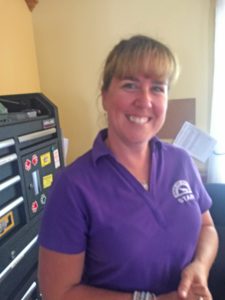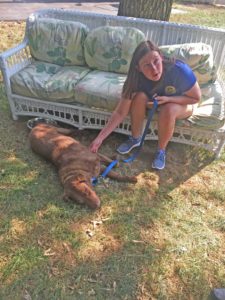This is the second in a series of posts about my visit to the Senior Dog Sanctuary (SDS) in Severn, MD.
When you think of a baseball team, you don’t envision a collection of bats and gloves and a field. Those things are necessary to play the game, of course, but they are just things. A baseball team is the players, the group of people who use the bats and gloves and field to play the game, for the benefit of the fans.
The same is true for a Dog Sanctuary like SDS. Like a baseball team, it has a physical setting: a building and grounds, with parking and kennels and a lobby. Behind the scenes, the managers must have a strategic plan and funding to keep the place running. But those are just things. The core of the enterprise is the team, the group of people who use those resources for the benefit of the dogs. If they made bubble gum cards for the SDS, they would not feature equipment or business plans; they would feature the amazing group of men and women (mostly women) who have banded together to make the Sanctuary a reality. They are the All-Stars.
I say this because I did not fully appreciate it coming in. When I put together my list of questions for the trip, I focused heavily on the facility, on management, animal care, and finances. All of those are essential to running a Sanctuary, of course. But Val told me repeatedly that the most crucial component is the people. He said you have to have three things to start a Sanctuary: time, money, and people; and of those three, the people are the most important. And after meeting the staff and volunteers of SDS, I now understand why.
On the day I visited SDS, I spent probably two hours talking to Debbie Gill, who is the Volunteer Coordinator. I spent another couple hours discussing staff (and a million other things) with Barb Turner, the Shelter Manager. I learned that SDS has 11 paid staff, many of them part time, for an equivalent of 6-7 full time employees. Besides Debbie and Barb, there are 9 kennel technicians who care for the dogs. There are two kennel technicians on duty at all times, from 6 AM to 8 PM. (I will talk more about them in a later post.) Barb lives in the attached house, so there is someone on the premises 24/7.
The relatively small staff is supported by a large number of volunteers. Debbie walked me through the nuts and bolts of recruiting, training, and scheduling volunteers — a huge task. I was surprised to learn that, only 18 months into its existence, the SDS has over 100 volunteers. They are asked to donate at least 4 hours a month, though many put in more time than that. I met volunteers from as young as 10 (with parental supervision) up to retirement age.

The volunteers fill a ton of roles at SDS. Some sign up for 2-hour shifts to walk and care for the dogs. There are two volunteer slots every shift, and they sign up for shifts online. Other volunteers do laundry, drive the dogs to the vet, clean, and do other day-to-day tasks. That much I expected. What I didn’t expect was the many leadership roles that volunteers fill. When they go through training, they are encouraged (though not required) to join one or more volunteer committees. There are seven of these committees. One reviews adoption applications, calling references and performing home visits (!) to choose good homes for the dogs. Another puts together a monthly newsletter; another handles fundraising. There are committees for Adoption/Foster Support, Photos, and Volunteer Night Out. In another post, I’ll talk about the Adoption Event Committee, which plans and carries out all of the public events they attend.

What impressed me most about the SDS Volunteers was how active they were in the organization, and how much say they have in creating programs and procedures. Having a committee doesn’t guarantee squat; I’ve sat on many useless committees in my time. But the administration at SDS has empowered the volunteers to think creatively, to show initiative, to take their ideas and run with them. And the volunteers have responded. If you know your ideas will be respected, and your efforts supported, it gives you incentive to try new things. It is a very successful arrangement. Whenever I commented positively on some aspect of the SDS, Val would invariably bump the praise to the staff and volunteers: “They’re the ones that came up with that. That was their idea.”
After seeing the staff and volunteers in action, my next question was, where do you find these wonderful people? Val’s answer: they will come to you. To stretch the baseball analogy, “If you build it, they will come.” There are a lot of dog lovers in the world. Many of them would love the opportunity to help old dogs; if you make it available, they will jump at the chance. Many of the workers I talked to had volunteered for years at other shelters or rescue operations. Like all dog people, they are compassionate, giving, willing to sacrifice for the good of the dogs. When they post a staff position on line, they usually receive 20 applicants. They once had an investment banker give up her job to become a kennel technician. Dog people are the salt of the Earth.
Some people have the false idea that all shelter workers do is “play with dogs all day.” Though interaction with dogs is important — and fun! — it is only a small part of what the staff of SDS does each day. They have to juggle a dozen balls at once: pleas for admission, vet visits, medical issues, potential adopters, staff scheduling, broken generators, public events, coordinating with other shelters… it was non-stop. It takes a ton of effort to save these dogs and find them a home. I have never met a more dedicated, selfless, hard-working group of men and women than the volunteers and staff at SDS. What they’ve been able to accomplish in 18 months is astounding. Dog people of SDS, my hat is off to you! Keep up the good work! I hope we can find others like you for our Sanctuary some day.
